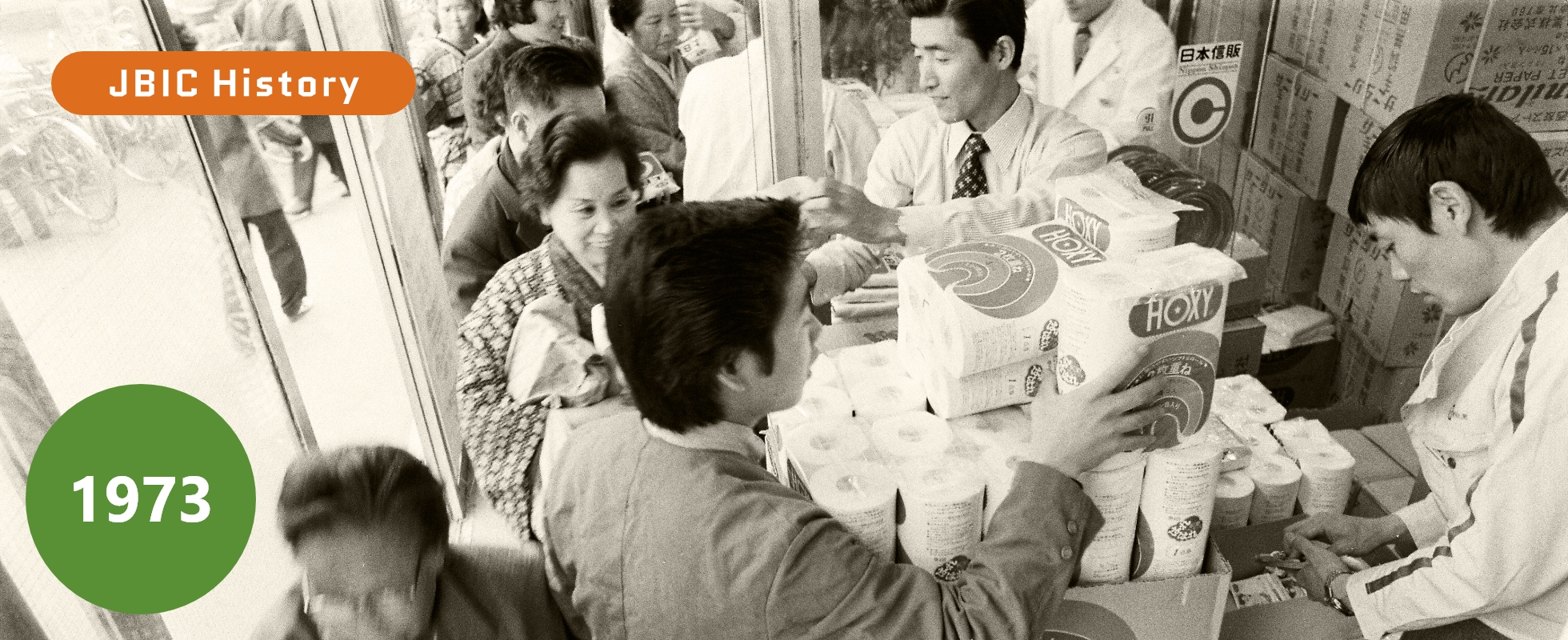JBIC History vol.3
The first oil crisis of 1973 prompted Japan to change its energy policy. JBIC’s predecessor, the Export-Import Bank of Japan (JEXIM), helped bring the financial side of the situation under control.


The oil crisis caused public panic, with consumers rushing to hoard goods (November 1973). The following year, Japan experienced its first economic contraction since the end of World War II. ©The Asahi Shimbun / amanaimages
Surging oil prices and an abrupt shift in the booming economy. Japan’s economy also saw “soaring prices”
The 1970s saw the world economy facing stagflation—simultaneous inflation and weak economic growth. This was triggered by the first oil crisis in 1973 when the Organization of Arab Petroleum Exporting Countries (OAPEC) decided to drastically raise the price of oil and restrict its supply in support of the Arab side in the fourth Arab-Israeli War, which broke out in October. The official price of oil quadrupled in less than three months, sending shock waves across the world.
The impact on the Japanese economy in particular was enormous due to the country’s heavy reliance on resource imports. The boom that had delivered Japan’s rapid growth and transformed it into an economic powerhouse abruptly ended. Fear spread among the public, leading to panic buying of goods including petroleum products, toilet paper, and detergents. In 1974, the economy contracted for the first time since the end of World War II, ushering in an era of low growth for the Japanese economy.
To facilitate cooperation between industrialized countries, they held the first G6 summit in Rambouillet, France, in November 1975. Following this, the first oil crisis appeared to be resolved, with the Middle East oil-producing countries easing production cuts and lifting the embargo against the U.S. However, crude oil prices stayed high, and rises spread to coal, natural gas, uranium, and other energy sources.
The second oil crisis, when the price of oil increased 2.7-fold in about three years, was triggered by the Iranian Revolution of February 1979 combined with the Iran-Iraq War that broke out in September 1980. Prices rose again in Japan, but major disruption was avoided due to the energy conservation, economic, and financial measures implemented after the first oil crisis.
The first oil crisis drove change JEXIM law amendment contributed to controlling the situation
In light of the impact of the first oil crisis, the government compiled the “Basic Direction for the Comprehensive Energy Policy” in December 1975. Energy policy was further strengthened as Japan sought to reduce dependence on imported oil and to diversify its alternative energy sources. To that end, JEXIM expanded loans related to resources such as petroleum, liquefied natural gas (LNG), and coal. JEXIM funds were also used for oil diplomacy: securing oil supplies through economic cooperation with petrostates.
There were also major changes in Japan’s industrial structure. Energy conservation pressure led to some industries suffering sharp drops in profitability and structural decline, along with the emergence of SMEs eager to embark on overseas trade and investment to tap into international markets. In response, the government bolstered the financial support system by JEXIM. In 1976, the Export-Import Bank of Japan Act was amended, raising the borrowing cap, allowing foreign currency bonds to be issued for raising capital, establishing a system for SMEs to more smoothly utilize JEXIM funds.
Energy supply stability is a vital determiner of a country’s future. The challenges that Japan faced due to the oil crisis prompted a major energy policy shift, and provided an opportunity to strengthen the presence of JEXIM’s domestic financing.
The oil crisis and response
by the Japanese government and JEXIM
| 1973 | October | Outbreak of the fourth Arab-Israeli War (1st Oil Crisis) |
|---|---|---|
| November | Panic buying in Japan | |
| December | Drastic rise in the official price of oil | |
| 1975 | November | 1st G6 Summit |
| 1976 | June | Partial amendment of the Export-Import Bank of Japan Act |
| 1979 | February | Iranian Revolution (2nd Oil Crisis) |
| 1980 | September | Iran-Iraq War |






